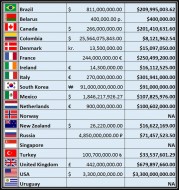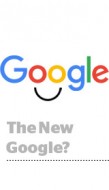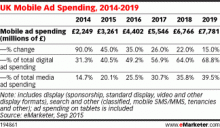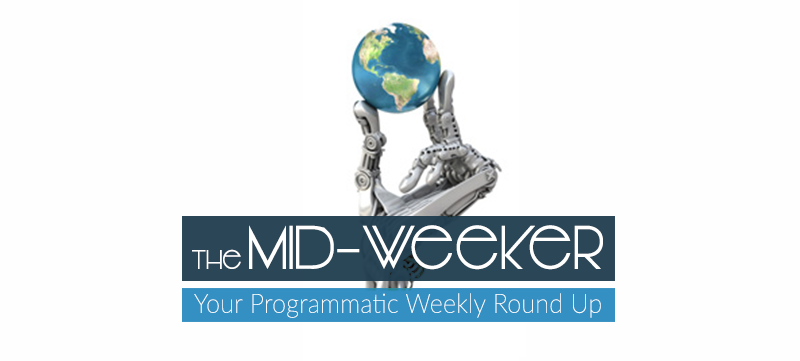Programmatic In-Read Video Sales Powering Dramatic Growth for Teads
 Teads, the video ad tech platform, which allows publishers to monetize video advertising in article pages, known as In-Read or Out-Stream, has registered 300 percent growth, for the first 8 months of 2015. This has been primarily powered by programmatic sales of publisher inventory, says Bertrand Queseda, CEO and Co-founder in this interview with Beet.TV . Watch the Video.
Teads, the video ad tech platform, which allows publishers to monetize video advertising in article pages, known as In-Read or Out-Stream, has registered 300 percent growth, for the first 8 months of 2015. This has been primarily powered by programmatic sales of publisher inventory, says Bertrand Queseda, CEO and Co-founder in this interview with Beet.TV . Watch the Video.
The Changing Handshake Of Programmatic Deals
 As private marketplaces have taken off, buyers and sellers have struggled to figure out exactly how to negotiate deals and, once a campaign is live, optimise so it actually delivers the expected values. PMPs have changed the dynamics of buyers and sellers to the point that none of the existing models work. One of the major hurdles for PMP deals is pricing. The rate cards used by publishers for direct deals are seen as too expensive for programmatic buyers and open marketplace prices used by buyers being too low for sellers. This article discusses why Publishers need to be promoting added incentives in the Private Marketplace that advertisers can’t get in an open marketplace while the Buy side needs to re-orientate away from an open marketplace mindset and to accept that using a PMP is a commitment. Read more.
As private marketplaces have taken off, buyers and sellers have struggled to figure out exactly how to negotiate deals and, once a campaign is live, optimise so it actually delivers the expected values. PMPs have changed the dynamics of buyers and sellers to the point that none of the existing models work. One of the major hurdles for PMP deals is pricing. The rate cards used by publishers for direct deals are seen as too expensive for programmatic buyers and open marketplace prices used by buyers being too low for sellers. This article discusses why Publishers need to be promoting added incentives in the Private Marketplace that advertisers can’t get in an open marketplace while the Buy side needs to re-orientate away from an open marketplace mindset and to accept that using a PMP is a commitment. Read more.
Programmatic Will Eat Half Of Display And Video Ad Budgets By 2019
 Programmatic buying of display and video ads will expand rapidly for years to come, according to new findings from Magna Global. In a forecast released Monday, Magna Global predicted that the amount of global ad inventory bought and sold using programmatic methods will rise 49% in 2015, compared to last year – reaching $14.2 billion worldwide. The report, covering 41 markets, was drawn from surveys of Magna Global’s external partners as well as third-party sources. It predicted that programmatic buying will grow at an average rate of 31% annually over the next four years, reaching $36.8 billion by 2019. Worldwide programmatic spend is expected to grow this year to 31% of banner display and video share (compared to 24% in 2014), and will increase to 50% by 2019. The report shows that despite the growing concerns concerning ad-blocking, ad-fraud and viewability, programmatic growth is still going strong and will continue its for years to come.Read more.
Programmatic buying of display and video ads will expand rapidly for years to come, according to new findings from Magna Global. In a forecast released Monday, Magna Global predicted that the amount of global ad inventory bought and sold using programmatic methods will rise 49% in 2015, compared to last year – reaching $14.2 billion worldwide. The report, covering 41 markets, was drawn from surveys of Magna Global’s external partners as well as third-party sources. It predicted that programmatic buying will grow at an average rate of 31% annually over the next four years, reaching $36.8 billion by 2019. Worldwide programmatic spend is expected to grow this year to 31% of banner display and video share (compared to 24% in 2014), and will increase to 50% by 2019. The report shows that despite the growing concerns concerning ad-blocking, ad-fraud and viewability, programmatic growth is still going strong and will continue its for years to come.Read more.
The IAB Releases New Report – The State Of The Digital World
 The IAB and its Digital Video centre of Excellence released the “IAB State of the Digital Video World” on Tuesday. The report researches into 19 IABs across the globe – Brazil, Belarus, Canada, Colombia, Denmark, France, Ireland, Italy, Mexico, the Netherlands, New Zealand, Norway, Russia, Singapore, Uruguay, South Korea, Turkey, and the United Kingdom, as well as the United States – to reveal country-specific digital video revenues, wireless and broadband availabilities, and the perceived importance of formats, platforms, and monetization strategies. The report gives a detailed overview of the differences from country to country such as where they see the greatest potential in digital video and how they rate different formats. Read more.
The IAB and its Digital Video centre of Excellence released the “IAB State of the Digital Video World” on Tuesday. The report researches into 19 IABs across the globe – Brazil, Belarus, Canada, Colombia, Denmark, France, Ireland, Italy, Mexico, the Netherlands, New Zealand, Norway, Russia, Singapore, Uruguay, South Korea, Turkey, and the United Kingdom, as well as the United States – to reveal country-specific digital video revenues, wireless and broadband availabilities, and the perceived importance of formats, platforms, and monetization strategies. The report gives a detailed overview of the differences from country to country such as where they see the greatest potential in digital video and how they rate different formats. Read more.
Google Allows Targeted Ads Based On First-Party Data
 Google announced on Monday that they will now let marketers use their first-party CRM data to target specific users based on hashed email addresses with a new product called Customer Match. While Facebook and Twitter both already enable first-party matching, that Google now allows it represents a seminal shift in advertising. According to Bhanu Narasimhan, Google’s Product Management Director for Adwords, Google’s offer will be unique because it will be based on search intent. Google believes combining its expertise in personalized search with Customer Match gives marketers capabilities that can’t be matched on social media platforms. But with these enhancements comes more stringent privacy restrictions, said Narasimhan. Google will now require that email addresses are given directly to the advertiser by the customer rather than purchasing a data-set and advertisers must disclose in their privacy policy. With these restrictions in play, it is up to advertisers to judge whether the benefits outweigh the cons of using Google’s new tool. Read more.
Google announced on Monday that they will now let marketers use their first-party CRM data to target specific users based on hashed email addresses with a new product called Customer Match. While Facebook and Twitter both already enable first-party matching, that Google now allows it represents a seminal shift in advertising. According to Bhanu Narasimhan, Google’s Product Management Director for Adwords, Google’s offer will be unique because it will be based on search intent. Google believes combining its expertise in personalized search with Customer Match gives marketers capabilities that can’t be matched on social media platforms. But with these enhancements comes more stringent privacy restrictions, said Narasimhan. Google will now require that email addresses are given directly to the advertiser by the customer rather than purchasing a data-set and advertisers must disclose in their privacy policy. With these restrictions in play, it is up to advertisers to judge whether the benefits outweigh the cons of using Google’s new tool. Read more.
Mobile Ad Spending to Overtake Print in the UK
 For the first time this year, mobile advertising expenditure in the UK will overtake spend on print advertising, according to the latest forecasts from eMarketer. Mobile ad spending has shown significant growth in recent years and is expected to rise 45% this year to over £3 billion ($4.94 billion) and will account for 20% of total media spending in the country. By comparison, spending on print will reach £2.67 billion ($4.40 billion), or 16.4% of total UK media spending in 2015. eMarketer predict that mobile will continue to make gains on other formats also and is soon set to match spending on TV, a key milestone for mobile. If their forecast ring through, TV’s share of UK total media ad spending will fall to 24.8% as mobile increases its portion to 25.5%. The following year, mobile will become the single largest ad channel in the UK market. Read more.
For the first time this year, mobile advertising expenditure in the UK will overtake spend on print advertising, according to the latest forecasts from eMarketer. Mobile ad spending has shown significant growth in recent years and is expected to rise 45% this year to over £3 billion ($4.94 billion) and will account for 20% of total media spending in the country. By comparison, spending on print will reach £2.67 billion ($4.40 billion), or 16.4% of total UK media spending in 2015. eMarketer predict that mobile will continue to make gains on other formats also and is soon set to match spending on TV, a key milestone for mobile. If their forecast ring through, TV’s share of UK total media ad spending will fall to 24.8% as mobile increases its portion to 25.5%. The following year, mobile will become the single largest ad channel in the UK market. Read more.
ComScore and Rentrak To Merge In Bid to Challenge Nielsen
 Measurement companies ComScore and Rentrak announced on Tuesday that they have reached a definitive agreement to merge. The merger will see Rentrak become a wholly owned subsidiary of ComScore. ComScore CEO Serge Matta will take the reins as CEO of the combined company and Bill Livek, Rentrak’s vice chairman and CEO, will serve as executive vice chairman and president after the merger. According to the companies, the basis for the merger is to introduce a comprehensive set of solutions for measuring media consumption and advertising cross-platform. ComScore’s strength is in digital audience measurement while Rentrak has historically excelled in census-based measurement around the box office and set-top box and video-on-demand. Together they hope they can mount a serious challenge to Nielsen which has firmly established itself as the leader of the measurement industry. Read more.
Measurement companies ComScore and Rentrak announced on Tuesday that they have reached a definitive agreement to merge. The merger will see Rentrak become a wholly owned subsidiary of ComScore. ComScore CEO Serge Matta will take the reins as CEO of the combined company and Bill Livek, Rentrak’s vice chairman and CEO, will serve as executive vice chairman and president after the merger. According to the companies, the basis for the merger is to introduce a comprehensive set of solutions for measuring media consumption and advertising cross-platform. ComScore’s strength is in digital audience measurement while Rentrak has historically excelled in census-based measurement around the box office and set-top box and video-on-demand. Together they hope they can mount a serious challenge to Nielsen which has firmly established itself as the leader of the measurement industry. Read more.
Check out our previous Mid-Weekers to keep up with the latest trends in the Programmatic World


